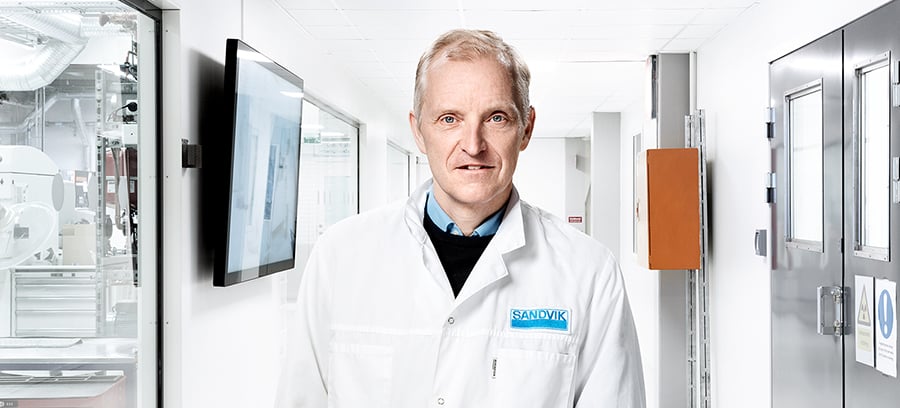Titanium powder in the world’s first smash-proof guitar
Selecting the right metal powder is a vital consideration in additive manufacturing (AM), as the quality and properties of the powder strongly influences the properties of the end-component. Simply put, there are three major aspects to consider: selection of raw material, particle size and morphology. Find out why we decided to go for titanium powder in the world’s first 3D-printed, smash-proof guitar. World famous by now – and tested by rock-legend Yngwie Malmsteen.
To get optimum results and uniform part build in additive manufacturing, it is essential to use high quality metal powders with good consistency. Based on more than 150-years of leading materials expertise and in-house powder manufacturing capabilities, Sandvik is expert at matching material to print process and application.
Why did you select titanium powder to build the guitar body?
“For the 3D-printed smash-proof guitar it was important to choose a material which enables both lightweight and strength. One of the most notable advantages of titanium is its strength. It’s among the strongest and most durable metals on the planet, which is why it’s used in so many industrial applications. In fact, titanium has the highest strength-to-density ratio of any metallic element on the periodic table”, says Pasi Kangas, VP and Chief Technology Officer at Sandvik Additive Manufacturing.
 “With Powder Bed Fusion Laser processes, when applying fresh powder layers to the powder bed, the precise particle size, excellent morphology and high packing density that our metal powders offer will always ensure uniform and consistent part build,” says Pasi Kangas.
“With Powder Bed Fusion Laser processes, when applying fresh powder layers to the powder bed, the precise particle size, excellent morphology and high packing density that our metal powders offer will always ensure uniform and consistent part build,” says Pasi Kangas.
The lightweight and strength of titanium is also well highlighted in aviation where the use of it in landing gear and compressor fans has drastically improved thrust to weight ratios. Titanium is also highly recyclable – and it is also biocompatible making it well suited to medical usage.
It’s also worth mentioning that titanium, also called the metal of the future, is generally more expensive than other types of metals. That is another reason why additive manufacturing is excellent as the choice of production technology when it comes to titanium, since it minimizes material waste.
Why are Sandvik’s powders so well-suited for additive manufacturing?
“For more than 40 years, Sandvik has been developing and manufacturing world-leading gas-atomized fine metal powders under the Osprey® brand – and we introduced powders for additive manufacturing already in 2002. Thanks to their spherical morphology, our AM-powders offer excellent flow and high packing density. These characteristics, along with their low surface oxide levels, make them ideally suited for in principle all additive manufacturing technologies”, says Pasi Kangas.
The printing technology selected for the body of the guitar was Powder Bed Fusion Laser. Can you comment on that?
“With Powder Bed Fusion Laser processes, when applying fresh powder layers to the powder bed, the precise particle size, excellent morphology and high packing density that our metal powders offer will always ensure uniform and consistent part build,” says Pasi Kangas.
Powder Bed Fusion Laser was selected as printing technology for the body of the smash-proof guitar. This method is ideal for design of very complex geometries. Laser technology is used to melt and fuse the titanium powder together. The melting process is repeated, layer by layer, until the last layer is melted and the printing is complete. Then the body is removed from the build plate and post-processed according to requirements.
Sandvik has nine gas atomization towers in-house for manufacturing of fine metal powders – seven in the UK and two in Sweden, where the company recently inaugurated a brand new, state-of-the-art titanium powder plant.
“Sandvik can offer everything from developmental batches of 1 kilo to 6000 kilos lots. Particle size can be adapted to fit any printing technique, from 5 to 500 microns”, says Pasi Kangas.
Before any print project, each batch of new powder is analyzed in Sandvik’s fully accredited metallurgical and powder laboratories. This is also critical for success.
Sandvik’s new powder plant for titanium is located in Sandviken, Sweden, just next to Sandvik’s additive manufacturing facility, which includes all relevant additive manufacturing processes for metals. This means that the company can tailor the powder to different printing processes, on the same site.
“Quality variations can negatively impact the printing process – and the end component. Our metal powders offer excellent consistency and the same high quality, both within batches and from batch to batch. Our customers can just tell us about their process requirements and end-applications – and then we can help them to tailor the particle size distribution range to optimize both performance and surface. We can also customize materials according to specifications”, says Pasi Kangas.
The management system of Sandvik’s new state-of-the art titanium powder plant and additive manufacturing operations in Sandviken have recently received the prestigious ‘AS9100 Revision D’ certification, for deliveries to the aerospace industry. The first two titanium powders produced at the plant are Osprey® Ti-6Al-4V Grade 5 and Osprey® Ti-6Al-4V Grade 23. Other alloys are available on request. In addition to the AS9100D certification, the plant is also certified according to ISO 9001, ISO 14001 and ISO 45001.